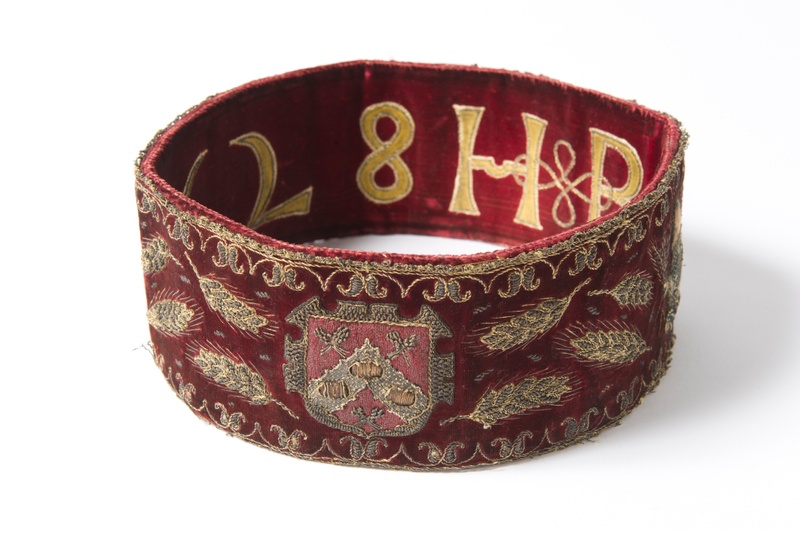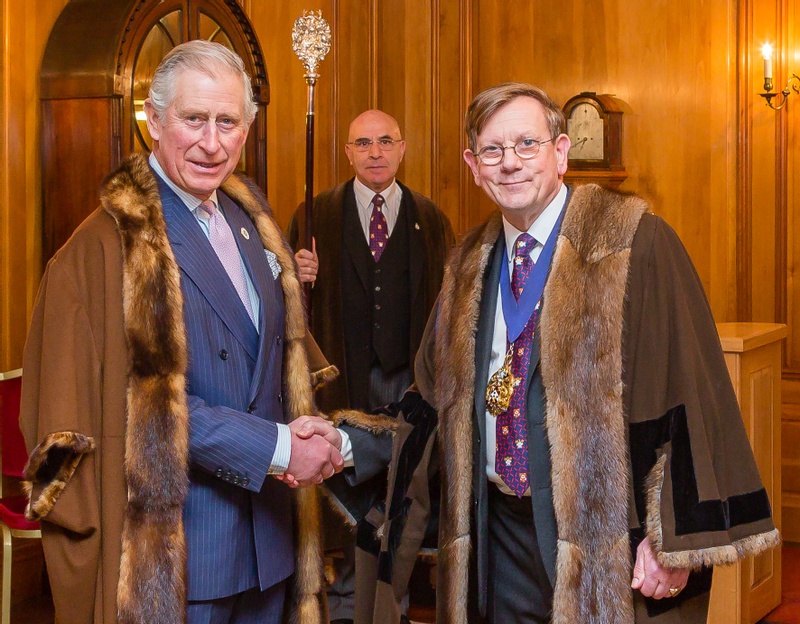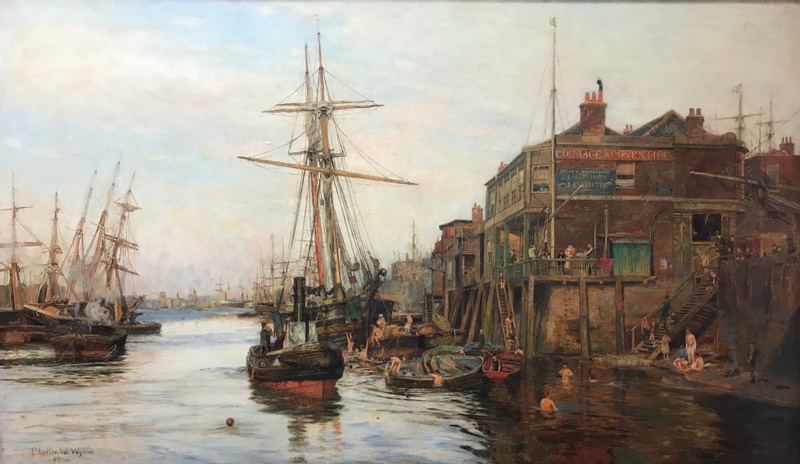Among the Company’s treasures are its archives, an almost unbroken run of minute books and other records from the 15th century to today. Much of the archive has been deposited at the Guildhall Library for safekeeping and where it can be accessed by researchers.
Memorandum Book of William Porlond
William Porlond was Clerk to the Brewers’ Company (the Chief Executive in modern terms) from 1418 to 1440. This unique book is his record of the affairs of the Company during this time and is of great significance since it is a very early example of official written English – most other records up to that time were in Latin or Norman French.
Porlond originally wrote in Latin or French but in 1422 he says he is going to follow the example of the King (Henry V) and Parliament and use English in future, because many brewers “have the knowledge of writing and reading in the said English idiom, but […] the Latin and French before these times used, they do not in anywise understand”.
The Memorandum Book contains many interesting items, including references to the protracted rows between the Brewers and Richard Whittington, Lord Mayor of the City of London. The book also contains one of the earliest recorded instances of the game of football – recording that in 1422-23 the Brewers received 20 pence from ‘ye Footballpleyers’ for the hire of Brewers’ Hall.
Wardens' Crowns
Historically, it was usual practice in many livery companies to place a crown or garland on the heads of newly elected Masters and Wardens in ceremonies to mark their installation as Senior Officers of their respective companies. Only six companies are known to still have early embroidered crowns in their collections, amongst which the Brewers’ are fortunate to feature, although they are no longer in use. The Carpenters’ and the Leathersellers’ are the only companies to continue using their original embroidered crowns in ceremonies.
Our three crowns or ‘garlands’ (so named as originally they would have been fresh floral garlands) were made in 1628-29 and entries in the accounts for the year show they cost £7 (£855 in today’s terms). There would have been another, probably more elaborate, crown for the Master, but this no longer survives. The initials inside each of them stand for the first three Wardens to wear them - John Heylyn, Henry Leake and Henry Bridges.
They are carefully embroidered with symbols which have special meaning for the Brewers including ears of barley, used in the production of malt, an ingredient used in brewing beer, and the coat of arms of the Brewers’ Company which includes three barrels of beer.
The Master’s badge
The practice of a badge of office for the Master seems to have been introduced during the second half of the 18th century. Every livery company has one but the beautiful, often bejewelled, examples worn today mostly date from the late 19th century. The Brewers’ Company Master’s badge is 17th century in style, with scrolling open work leaf design as the frame and the Company arms, helm, crest and motto in the centre. The charges are in heavy relief with the helm and crest modelled in three dimensions. It was presented to the Company in 1900 by William Thomas Paulin, Master in 1896-7. The Master’s badge is still in use today and is worn by the Master when representing the Company in an official capacity.


The Mistress’s brooch
This is a modern piece of jewellery, the gift of Richard Lees-Jones, Master 2001-2. An oval wreath of hops and ears of barley surrounds a shield with the Company coat of arms: three gold tuns in a diamond set chevron, which in turn is on a ruby set ground with three gold crossed barley sheaves.
Bargemaster’s Badge
This large silver badge, made by John Bird of London in 1727, was worn on the upper sleeve of the Company’s own Bargemaster, who was in charge of the Company’s barge on the River Thames. The Company had its own barge until it was sold in 1830.
Most Livery Companies had a barge, used on ceremonial occasions such as the river procession each November to celebrate the new Lord Mayor. This is the origin of today’s Lord Mayor’s Show. We still refer to ‘floats’ in this parade, a reminder that until 1856 they really did float along the Thames.
The Bargemaster’s Badge has since been converted into a snuff box; the oak is carved with sprays of barley and hops.
Beadle’s mace
Just over 2 metres in length, the Beadle’s mace dates from the late 17th century. The head is a silver badge with some gilding, of the Company’s coat of arms. It is held by the Beadle at all ceremonial occasions.
Funeral Pall
The Pall Cloth was made in the early 1500s and used at the funerals of all members, as a cover for the coffin. Company funerals were not only occasions for Liverymen to mourn the loss of one of their fellow members, but also an important way of ‘corporate bonding’, usually with a feast following the burial. The pall cloth covered the coffins of Past Masters, Wardens, and ordinary Liverymen alike, and emphasised their equality in death – but was also a status symbol, representing the pride which Brewers felt in identifying with their Company.
The pall cloth consists of a central panel of gold cloth, probably Italian, with a woven pattern of coiling stems, leaves and flowers, in red velvet pile and gold loops, and four side panels of red velvet, with very fine needlework showing symbols of importance to the Brewers: ears of barley, the Company’s coat of arms, and images of our patron saint, Thomas Becket, along with the Virgin Mary. Latin verses from the burial service are included.
Most Livery pall cloths were destroyed or sold after the Reformation, owing to the religious images they displayed. The Brewers are one of a lucky, select few to retain a medieval pall cloth to this day, along with the Fishmongers, Merchant Taylors, Ironmongers, Vintners, Saddlers and Parish Clerks.

Death mask of Dame Alice Owen
This is perhaps the most curious item in the collection. Dame Alice Owen founded the eponymous school, originally in Islington where she lived but now in more spacious surroundings in Potters Bar, and established almshouses for the elderly. The story is that as a girl she narrowly missed being shot by an arrow by someone doing target practice. She vowed to do good works in later life as thanks for her narrow escape. Married three times, once to a Brewer, she become a wealthy widow. In her will she appointed the Brewers’ Company to be her Trustee. The Company is still closely involved with the school over 400 years later.
Dame Alice died aged 66 in 1613. Within hours of her death, an impression of her face and hand was taken, using wax, and from that a plaster cast was then made to create a death mask. Before the age of photography, this was a way to preserve a true image of what someone looked like.
Silver and plated ware
The Company has a collection of silver which has been presented or, in some cases, loaned. Unfortunately, nothing survives from the early days despite the plate and pictures being saved from the Great Fire of London in 1666, when the hall itself was destroyed. The Company had great difficulty in raising the money for a new hall so those items were pawned to raise funds, and later the Company was unable to afford to redeem them.
The collection today consists of not just pieces usually found in livery companies – standing cups and covers, rose and punch bowls, trays, candelabra, cruets – but also a fine selection of items reflecting our core trade, including lidded tankards (mostly 18th century but two date from the 1680s), a model of a mash tun in copper steel (presented by Oliver Wells, 1991), a figure of a fourteen point Hertfordshire stag (the gift of Peter Furness-Smith of McMullen & Sons, Master 2016), a figure of the Young’s ram (the gift of Stephen Goodyear of Youngs, Master 2013), and a Victorian silver plated model of a dray with three barrels and buckets (the gift of Christopher Brain, Master 2008).

Knife and fork
One of the oldest pieces of silverware in the collection is a late 17th century knife and fork. Forks were still a novelty in England at this time, not coming into general use until the 1700s. The fashion for using them came from Italy and Spain, and the Master’s use of a fork to eat with at Brewers’ Hall would have had a touch of the exotic about it.
The leather case decorated with silver bears the inscription “Ex dono Richard Haley to ye Worshipful Brewers Company Mr. Robt. Breeden Master and for ye Use of Every Master for the time being, 1691". The silver embellishments include the Company’s coat of arms and even the hinges are engraved with flowers and thistles. The ends of the knife and two-pronged fork show the Company’s heraldic emblem of the Moorish lady holding ears of barley.
The Charrington Cup
This important silver cup and cover was made by Sir Alfred Gilbert (1854-1934), a leading sculptor and silversmith. As a boy he went to Aldenham School – his father taught music there for over 30 years – and he sent his own sons there too.
Gilbert’s best known work is world famous: the Shaftesbury Memorial Fountain (commonly known as Eros) in Piccadilly Circus. It is one of London’s most iconic landmarks and Aldenham School has a copy in the school grounds; a race takes place between the two statues each year.
One of Gilbert’s last works, the small figure at the top was not finished when he died and no one knows who it was going to represent. The cup was commissioned by Cecil Charrington, a Past Master (1930-1) and a famous brewer. His grandfather was a friend of Gilbert’s. After Gilbert died, Cecil gave the cup to the Brewers’ Company and had it engraved with a Latin inscription which states that Gilbert was an Old Aldenhamian.

Paintings and Prints
The Company is fortunate to have a fine selection of paintings and prints which have either been given or are on loan. Further details are given in the gallery.
Ceramics
In the Court Room are two fine Regency display cabinets containing a collection of ceramics and glassware, donated to the Company by Past Masters. The pieces are mostly rare Staffordshire and Derby figures, 200-250 years old, including the one pictured here called ‘Dray Men’, showing two thirsty draymen sharing a foaming tankard of ale.
There are also two distinctive pieces of Sussex Ware from the Rye Pottery. The one shown is a loving cup (with two handles so it could, theoretically at least, be offered person to person) from circa 1850. Profusely decorated with hops and barley on pots made of local clay with a lead glaze, this is typical of the pottery’s output.




























